PPMP20009 Project Management Methodologies Consolidated Portfolio 2017
VerifiedAdded on 2023/06/15
|6
|1750
|127
Report
AI Summary
This report provides an overview of project management methodologies, emphasizing their importance in organizational contexts. It addresses the reasons organizations adopt these methodologies, critically analyzes their impact on stakeholders, and explains the major elements required to meet organizational needs. The report highlights the significance of effective scoping, planning, resourcing, and management support for project success. It also discusses the role of agile project management and the use of non-traditional tools like NPD PPM software. The analysis covers both the positive and negative impacts of projects on stakeholders, such as the effects of construction projects on communities. Furthermore, it identifies key elements like cost, planning, logistics, and risk management as crucial for successful project execution, concluding that project management is integral to modern business operations.

PROJECT MANAGEMNET METHODOLOGIES
PPMP20009
Consolidated Portfolio
STUDENT NAME: <insert>
STUDENT ID: <insert>
LECTURER: <insert>
CAMPUS: <insert>
TERM: 3, 2017
PPMP20009
Consolidated Portfolio
STUDENT NAME: <insert>
STUDENT ID: <insert>
LECTURER: <insert>
CAMPUS: <insert>
TERM: 3, 2017
Paraphrase This Document
Need a fresh take? Get an instant paraphrase of this document with our AI Paraphraser
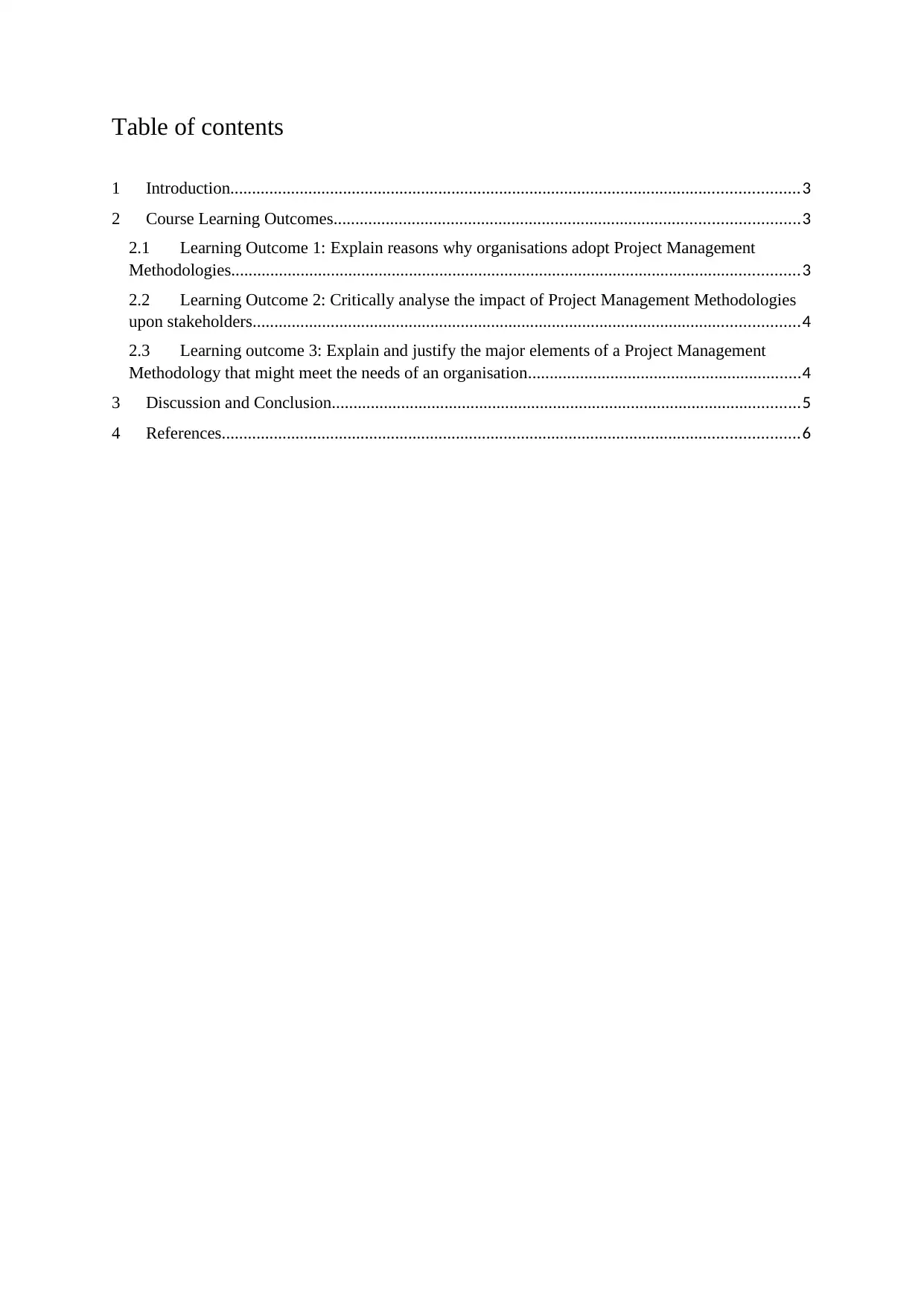
Table of contents
1 Introduction...................................................................................................................................3
2 Course Learning Outcomes...........................................................................................................3
2.1 Learning Outcome 1: Explain reasons why organisations adopt Project Management
Methodologies...................................................................................................................................3
2.2 Learning Outcome 2: Critically analyse the impact of Project Management Methodologies
upon stakeholders..............................................................................................................................4
2.3 Learning outcome 3: Explain and justify the major elements of a Project Management
Methodology that might meet the needs of an organisation...............................................................4
3 Discussion and Conclusion............................................................................................................5
4 References.....................................................................................................................................6
1 Introduction...................................................................................................................................3
2 Course Learning Outcomes...........................................................................................................3
2.1 Learning Outcome 1: Explain reasons why organisations adopt Project Management
Methodologies...................................................................................................................................3
2.2 Learning Outcome 2: Critically analyse the impact of Project Management Methodologies
upon stakeholders..............................................................................................................................4
2.3 Learning outcome 3: Explain and justify the major elements of a Project Management
Methodology that might meet the needs of an organisation...............................................................4
3 Discussion and Conclusion............................................................................................................5
4 References.....................................................................................................................................6
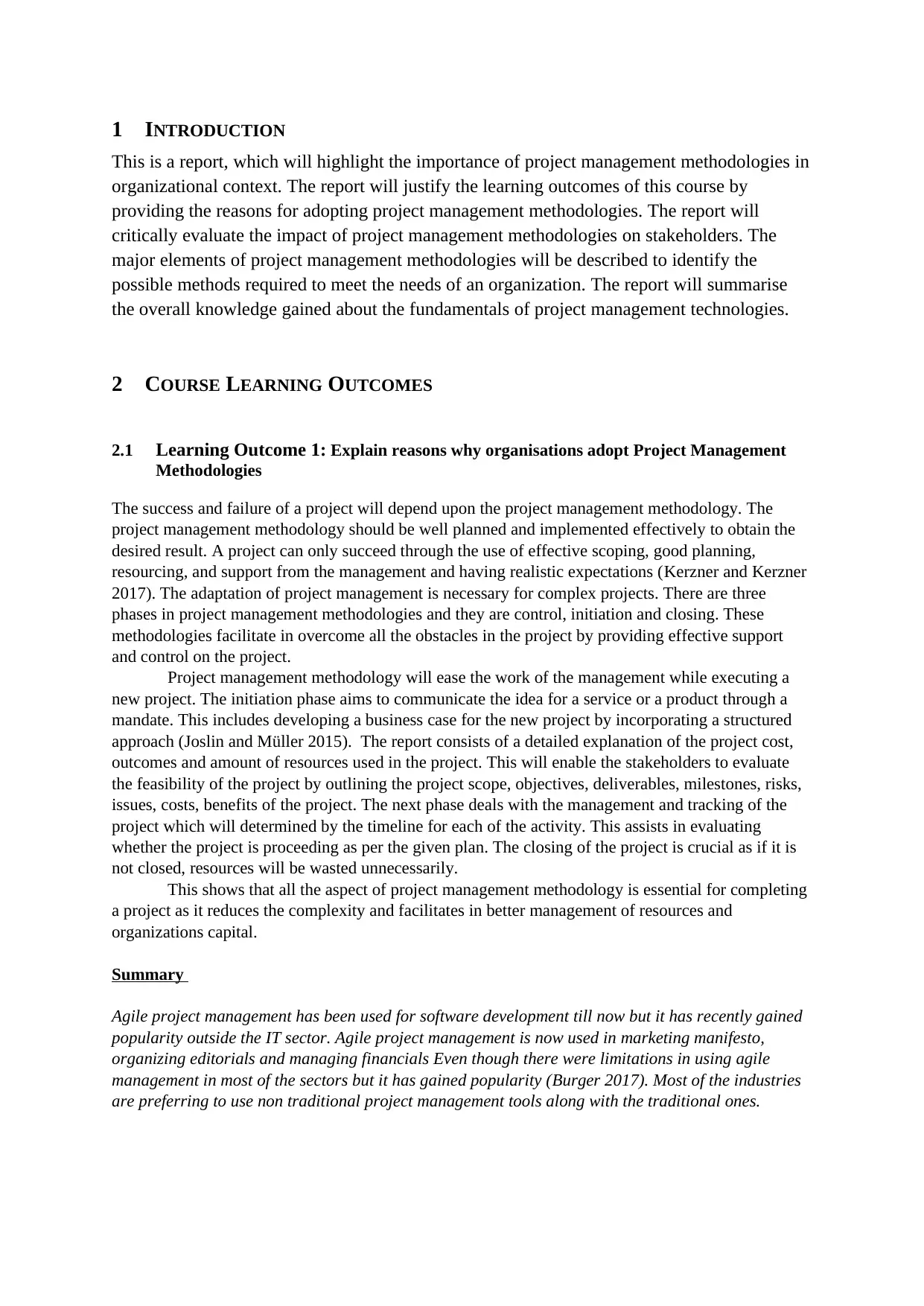
1 INTRODUCTION
This is a report, which will highlight the importance of project management methodologies in
organizational context. The report will justify the learning outcomes of this course by
providing the reasons for adopting project management methodologies. The report will
critically evaluate the impact of project management methodologies on stakeholders. The
major elements of project management methodologies will be described to identify the
possible methods required to meet the needs of an organization. The report will summarise
the overall knowledge gained about the fundamentals of project management technologies.
2 COURSE LEARNING OUTCOMES
2.1 Learning Outcome 1: Explain reasons why organisations adopt Project Management
Methodologies
The success and failure of a project will depend upon the project management methodology. The
project management methodology should be well planned and implemented effectively to obtain the
desired result. A project can only succeed through the use of effective scoping, good planning,
resourcing, and support from the management and having realistic expectations (Kerzner and Kerzner
2017). The adaptation of project management is necessary for complex projects. There are three
phases in project management methodologies and they are control, initiation and closing. These
methodologies facilitate in overcome all the obstacles in the project by providing effective support
and control on the project.
Project management methodology will ease the work of the management while executing a
new project. The initiation phase aims to communicate the idea for a service or a product through a
mandate. This includes developing a business case for the new project by incorporating a structured
approach (Joslin and Müller 2015). The report consists of a detailed explanation of the project cost,
outcomes and amount of resources used in the project. This will enable the stakeholders to evaluate
the feasibility of the project by outlining the project scope, objectives, deliverables, milestones, risks,
issues, costs, benefits of the project. The next phase deals with the management and tracking of the
project which will determined by the timeline for each of the activity. This assists in evaluating
whether the project is proceeding as per the given plan. The closing of the project is crucial as if it is
not closed, resources will be wasted unnecessarily.
This shows that all the aspect of project management methodology is essential for completing
a project as it reduces the complexity and facilitates in better management of resources and
organizations capital.
Summary
Agile project management has been used for software development till now but it has recently gained
popularity outside the IT sector. Agile project management is now used in marketing manifesto,
organizing editorials and managing financials Even though there were limitations in using agile
management in most of the sectors but it has gained popularity (Burger 2017). Most of the industries
are preferring to use non traditional project management tools along with the traditional ones.
This is a report, which will highlight the importance of project management methodologies in
organizational context. The report will justify the learning outcomes of this course by
providing the reasons for adopting project management methodologies. The report will
critically evaluate the impact of project management methodologies on stakeholders. The
major elements of project management methodologies will be described to identify the
possible methods required to meet the needs of an organization. The report will summarise
the overall knowledge gained about the fundamentals of project management technologies.
2 COURSE LEARNING OUTCOMES
2.1 Learning Outcome 1: Explain reasons why organisations adopt Project Management
Methodologies
The success and failure of a project will depend upon the project management methodology. The
project management methodology should be well planned and implemented effectively to obtain the
desired result. A project can only succeed through the use of effective scoping, good planning,
resourcing, and support from the management and having realistic expectations (Kerzner and Kerzner
2017). The adaptation of project management is necessary for complex projects. There are three
phases in project management methodologies and they are control, initiation and closing. These
methodologies facilitate in overcome all the obstacles in the project by providing effective support
and control on the project.
Project management methodology will ease the work of the management while executing a
new project. The initiation phase aims to communicate the idea for a service or a product through a
mandate. This includes developing a business case for the new project by incorporating a structured
approach (Joslin and Müller 2015). The report consists of a detailed explanation of the project cost,
outcomes and amount of resources used in the project. This will enable the stakeholders to evaluate
the feasibility of the project by outlining the project scope, objectives, deliverables, milestones, risks,
issues, costs, benefits of the project. The next phase deals with the management and tracking of the
project which will determined by the timeline for each of the activity. This assists in evaluating
whether the project is proceeding as per the given plan. The closing of the project is crucial as if it is
not closed, resources will be wasted unnecessarily.
This shows that all the aspect of project management methodology is essential for completing
a project as it reduces the complexity and facilitates in better management of resources and
organizations capital.
Summary
Agile project management has been used for software development till now but it has recently gained
popularity outside the IT sector. Agile project management is now used in marketing manifesto,
organizing editorials and managing financials Even though there were limitations in using agile
management in most of the sectors but it has gained popularity (Burger 2017). Most of the industries
are preferring to use non traditional project management tools along with the traditional ones.
⊘ This is a preview!⊘
Do you want full access?
Subscribe today to unlock all pages.

Trusted by 1+ million students worldwide
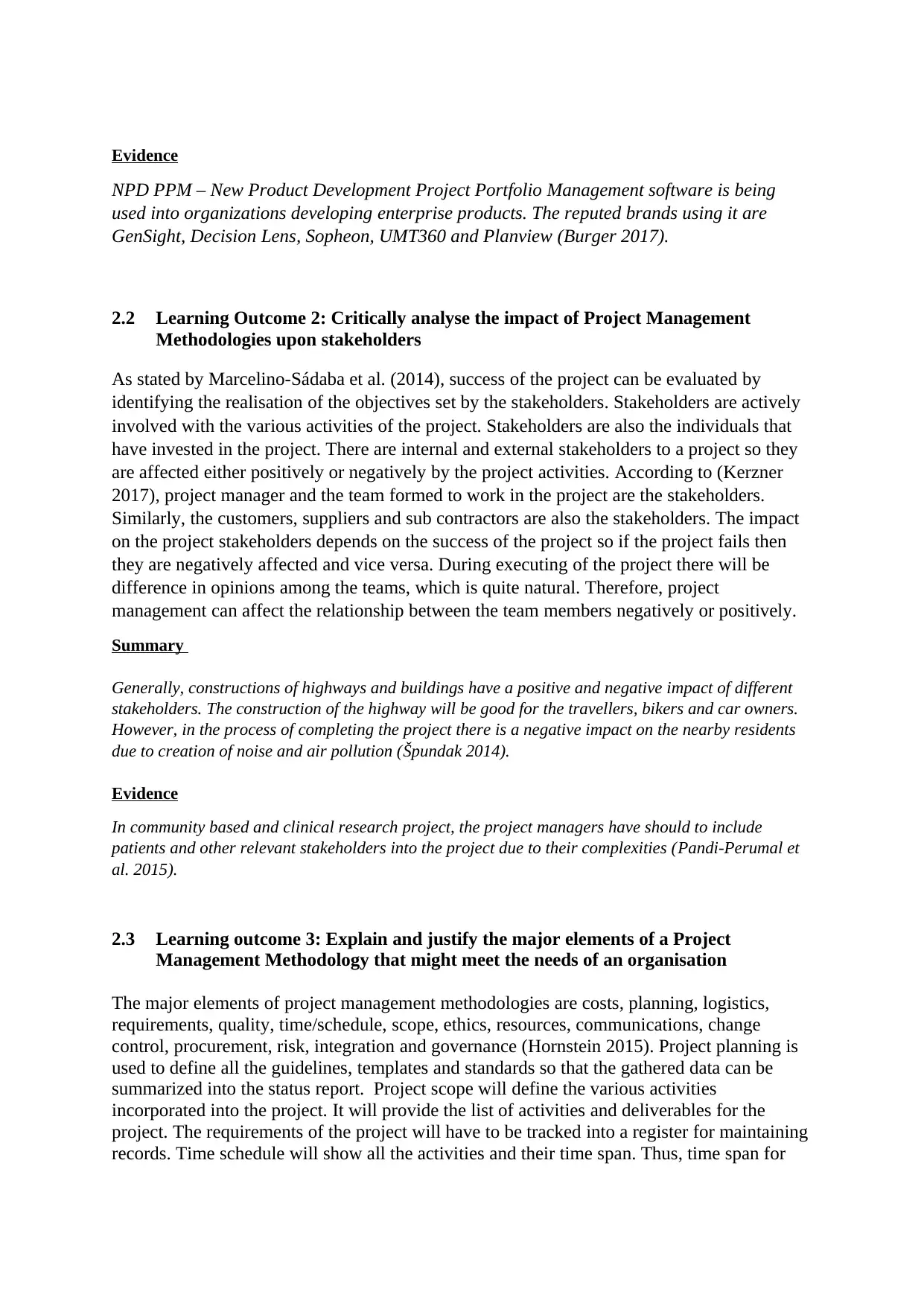
Evidence
NPD PPM – New Product Development Project Portfolio Management software is being
used into organizations developing enterprise products. The reputed brands using it are
GenSight, Decision Lens, Sopheon, UMT360 and Planview (Burger 2017).
2.2 Learning Outcome 2: Critically analyse the impact of Project Management
Methodologies upon stakeholders
As stated by Marcelino-Sádaba et al. (2014), success of the project can be evaluated by
identifying the realisation of the objectives set by the stakeholders. Stakeholders are actively
involved with the various activities of the project. Stakeholders are also the individuals that
have invested in the project. There are internal and external stakeholders to a project so they
are affected either positively or negatively by the project activities. According to (Kerzner
2017), project manager and the team formed to work in the project are the stakeholders.
Similarly, the customers, suppliers and sub contractors are also the stakeholders. The impact
on the project stakeholders depends on the success of the project so if the project fails then
they are negatively affected and vice versa. During executing of the project there will be
difference in opinions among the teams, which is quite natural. Therefore, project
management can affect the relationship between the team members negatively or positively.
Summary
Generally, constructions of highways and buildings have a positive and negative impact of different
stakeholders. The construction of the highway will be good for the travellers, bikers and car owners.
However, in the process of completing the project there is a negative impact on the nearby residents
due to creation of noise and air pollution (Špundak 2014).
Evidence
In community based and clinical research project, the project managers have should to include
patients and other relevant stakeholders into the project due to their complexities (Pandi-Perumal et
al. 2015).
2.3 Learning outcome 3: Explain and justify the major elements of a Project
Management Methodology that might meet the needs of an organisation
The major elements of project management methodologies are costs, planning, logistics,
requirements, quality, time/schedule, scope, ethics, resources, communications, change
control, procurement, risk, integration and governance (Hornstein 2015). Project planning is
used to define all the guidelines, templates and standards so that the gathered data can be
summarized into the status report. Project scope will define the various activities
incorporated into the project. It will provide the list of activities and deliverables for the
project. The requirements of the project will have to be tracked into a register for maintaining
records. Time schedule will show all the activities and their time span. Thus, time span for
NPD PPM – New Product Development Project Portfolio Management software is being
used into organizations developing enterprise products. The reputed brands using it are
GenSight, Decision Lens, Sopheon, UMT360 and Planview (Burger 2017).
2.2 Learning Outcome 2: Critically analyse the impact of Project Management
Methodologies upon stakeholders
As stated by Marcelino-Sádaba et al. (2014), success of the project can be evaluated by
identifying the realisation of the objectives set by the stakeholders. Stakeholders are actively
involved with the various activities of the project. Stakeholders are also the individuals that
have invested in the project. There are internal and external stakeholders to a project so they
are affected either positively or negatively by the project activities. According to (Kerzner
2017), project manager and the team formed to work in the project are the stakeholders.
Similarly, the customers, suppliers and sub contractors are also the stakeholders. The impact
on the project stakeholders depends on the success of the project so if the project fails then
they are negatively affected and vice versa. During executing of the project there will be
difference in opinions among the teams, which is quite natural. Therefore, project
management can affect the relationship between the team members negatively or positively.
Summary
Generally, constructions of highways and buildings have a positive and negative impact of different
stakeholders. The construction of the highway will be good for the travellers, bikers and car owners.
However, in the process of completing the project there is a negative impact on the nearby residents
due to creation of noise and air pollution (Špundak 2014).
Evidence
In community based and clinical research project, the project managers have should to include
patients and other relevant stakeholders into the project due to their complexities (Pandi-Perumal et
al. 2015).
2.3 Learning outcome 3: Explain and justify the major elements of a Project
Management Methodology that might meet the needs of an organisation
The major elements of project management methodologies are costs, planning, logistics,
requirements, quality, time/schedule, scope, ethics, resources, communications, change
control, procurement, risk, integration and governance (Hornstein 2015). Project planning is
used to define all the guidelines, templates and standards so that the gathered data can be
summarized into the status report. Project scope will define the various activities
incorporated into the project. It will provide the list of activities and deliverables for the
project. The requirements of the project will have to be tracked into a register for maintaining
records. Time schedule will show all the activities and their time span. Thus, time span for
Paraphrase This Document
Need a fresh take? Get an instant paraphrase of this document with our AI Paraphraser
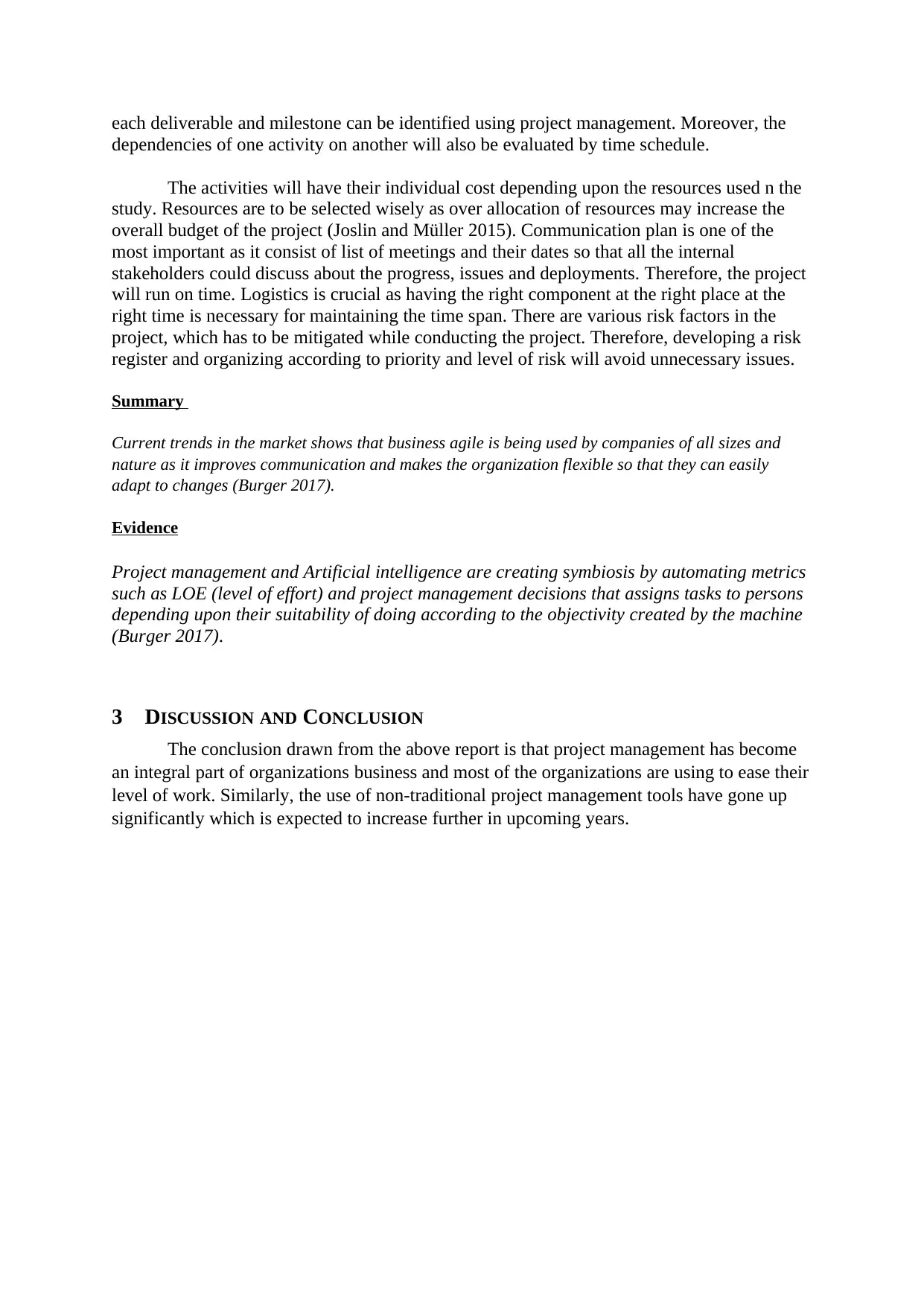
each deliverable and milestone can be identified using project management. Moreover, the
dependencies of one activity on another will also be evaluated by time schedule.
The activities will have their individual cost depending upon the resources used n the
study. Resources are to be selected wisely as over allocation of resources may increase the
overall budget of the project (Joslin and Müller 2015). Communication plan is one of the
most important as it consist of list of meetings and their dates so that all the internal
stakeholders could discuss about the progress, issues and deployments. Therefore, the project
will run on time. Logistics is crucial as having the right component at the right place at the
right time is necessary for maintaining the time span. There are various risk factors in the
project, which has to be mitigated while conducting the project. Therefore, developing a risk
register and organizing according to priority and level of risk will avoid unnecessary issues.
Summary
Current trends in the market shows that business agile is being used by companies of all sizes and
nature as it improves communication and makes the organization flexible so that they can easily
adapt to changes (Burger 2017).
Evidence
Project management and Artificial intelligence are creating symbiosis by automating metrics
such as LOE (level of effort) and project management decisions that assigns tasks to persons
depending upon their suitability of doing according to the objectivity created by the machine
(Burger 2017).
3 DISCUSSION AND CONCLUSION
The conclusion drawn from the above report is that project management has become
an integral part of organizations business and most of the organizations are using to ease their
level of work. Similarly, the use of non-traditional project management tools have gone up
significantly which is expected to increase further in upcoming years.
dependencies of one activity on another will also be evaluated by time schedule.
The activities will have their individual cost depending upon the resources used n the
study. Resources are to be selected wisely as over allocation of resources may increase the
overall budget of the project (Joslin and Müller 2015). Communication plan is one of the
most important as it consist of list of meetings and their dates so that all the internal
stakeholders could discuss about the progress, issues and deployments. Therefore, the project
will run on time. Logistics is crucial as having the right component at the right place at the
right time is necessary for maintaining the time span. There are various risk factors in the
project, which has to be mitigated while conducting the project. Therefore, developing a risk
register and organizing according to priority and level of risk will avoid unnecessary issues.
Summary
Current trends in the market shows that business agile is being used by companies of all sizes and
nature as it improves communication and makes the organization flexible so that they can easily
adapt to changes (Burger 2017).
Evidence
Project management and Artificial intelligence are creating symbiosis by automating metrics
such as LOE (level of effort) and project management decisions that assigns tasks to persons
depending upon their suitability of doing according to the objectivity created by the machine
(Burger 2017).
3 DISCUSSION AND CONCLUSION
The conclusion drawn from the above report is that project management has become
an integral part of organizations business and most of the organizations are using to ease their
level of work. Similarly, the use of non-traditional project management tools have gone up
significantly which is expected to increase further in upcoming years.
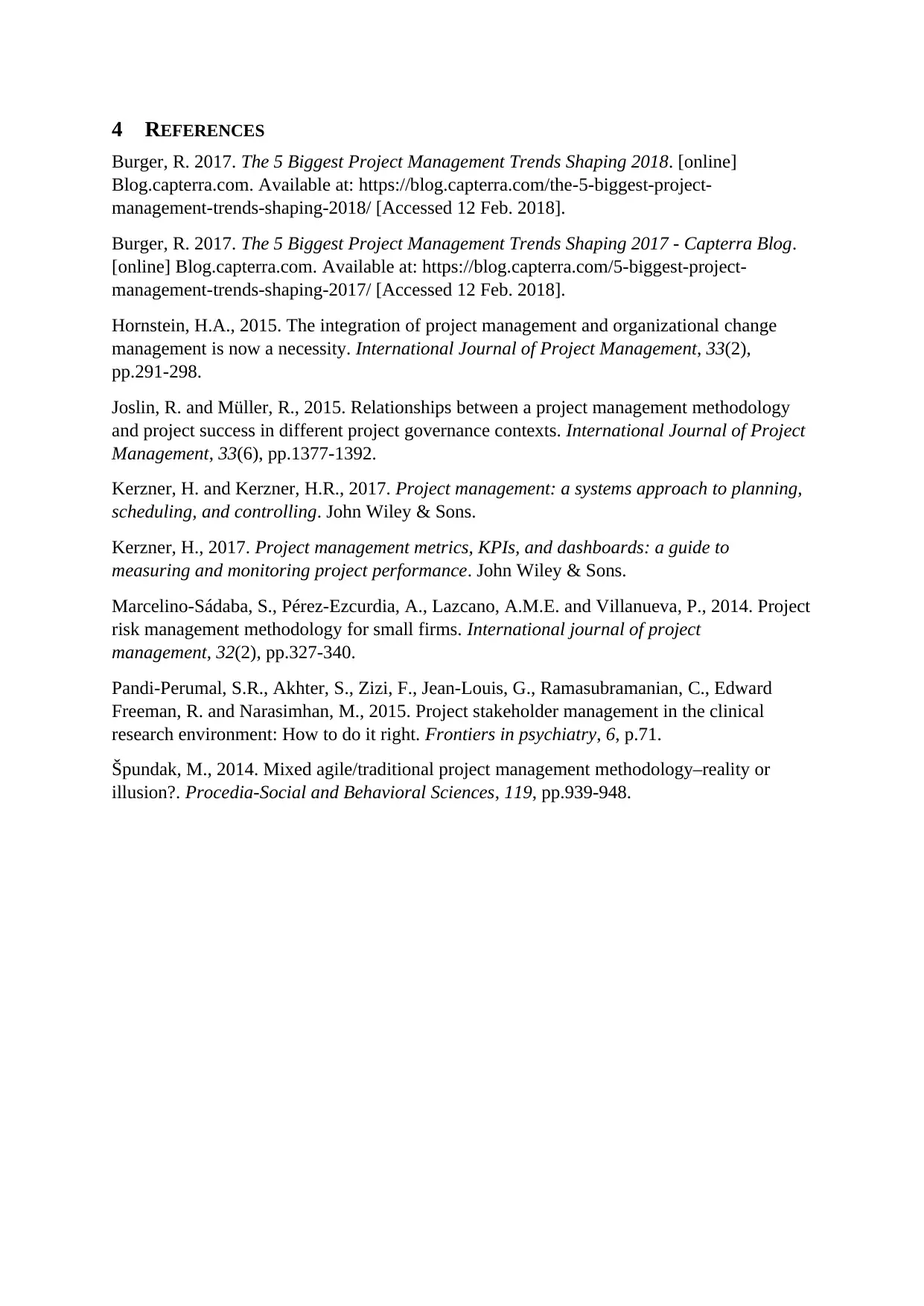
4 REFERENCES
Burger, R. 2017. The 5 Biggest Project Management Trends Shaping 2018. [online]
Blog.capterra.com. Available at: https://blog.capterra.com/the-5-biggest-project-
management-trends-shaping-2018/ [Accessed 12 Feb. 2018].
Burger, R. 2017. The 5 Biggest Project Management Trends Shaping 2017 - Capterra Blog.
[online] Blog.capterra.com. Available at: https://blog.capterra.com/5-biggest-project-
management-trends-shaping-2017/ [Accessed 12 Feb. 2018].
Hornstein, H.A., 2015. The integration of project management and organizational change
management is now a necessity. International Journal of Project Management, 33(2),
pp.291-298.
Joslin, R. and Müller, R., 2015. Relationships between a project management methodology
and project success in different project governance contexts. International Journal of Project
Management, 33(6), pp.1377-1392.
Kerzner, H. and Kerzner, H.R., 2017. Project management: a systems approach to planning,
scheduling, and controlling. John Wiley & Sons.
Kerzner, H., 2017. Project management metrics, KPIs, and dashboards: a guide to
measuring and monitoring project performance. John Wiley & Sons.
Marcelino-Sádaba, S., Pérez-Ezcurdia, A., Lazcano, A.M.E. and Villanueva, P., 2014. Project
risk management methodology for small firms. International journal of project
management, 32(2), pp.327-340.
Pandi-Perumal, S.R., Akhter, S., Zizi, F., Jean-Louis, G., Ramasubramanian, C., Edward
Freeman, R. and Narasimhan, M., 2015. Project stakeholder management in the clinical
research environment: How to do it right. Frontiers in psychiatry, 6, p.71.
Špundak, M., 2014. Mixed agile/traditional project management methodology–reality or
illusion?. Procedia-Social and Behavioral Sciences, 119, pp.939-948.
Burger, R. 2017. The 5 Biggest Project Management Trends Shaping 2018. [online]
Blog.capterra.com. Available at: https://blog.capterra.com/the-5-biggest-project-
management-trends-shaping-2018/ [Accessed 12 Feb. 2018].
Burger, R. 2017. The 5 Biggest Project Management Trends Shaping 2017 - Capterra Blog.
[online] Blog.capterra.com. Available at: https://blog.capterra.com/5-biggest-project-
management-trends-shaping-2017/ [Accessed 12 Feb. 2018].
Hornstein, H.A., 2015. The integration of project management and organizational change
management is now a necessity. International Journal of Project Management, 33(2),
pp.291-298.
Joslin, R. and Müller, R., 2015. Relationships between a project management methodology
and project success in different project governance contexts. International Journal of Project
Management, 33(6), pp.1377-1392.
Kerzner, H. and Kerzner, H.R., 2017. Project management: a systems approach to planning,
scheduling, and controlling. John Wiley & Sons.
Kerzner, H., 2017. Project management metrics, KPIs, and dashboards: a guide to
measuring and monitoring project performance. John Wiley & Sons.
Marcelino-Sádaba, S., Pérez-Ezcurdia, A., Lazcano, A.M.E. and Villanueva, P., 2014. Project
risk management methodology for small firms. International journal of project
management, 32(2), pp.327-340.
Pandi-Perumal, S.R., Akhter, S., Zizi, F., Jean-Louis, G., Ramasubramanian, C., Edward
Freeman, R. and Narasimhan, M., 2015. Project stakeholder management in the clinical
research environment: How to do it right. Frontiers in psychiatry, 6, p.71.
Špundak, M., 2014. Mixed agile/traditional project management methodology–reality or
illusion?. Procedia-Social and Behavioral Sciences, 119, pp.939-948.
⊘ This is a preview!⊘
Do you want full access?
Subscribe today to unlock all pages.

Trusted by 1+ million students worldwide
1 out of 6
Related Documents
Your All-in-One AI-Powered Toolkit for Academic Success.
+13062052269
info@desklib.com
Available 24*7 on WhatsApp / Email
![[object Object]](/_next/static/media/star-bottom.7253800d.svg)
Unlock your academic potential
Copyright © 2020–2025 A2Z Services. All Rights Reserved. Developed and managed by ZUCOL.


